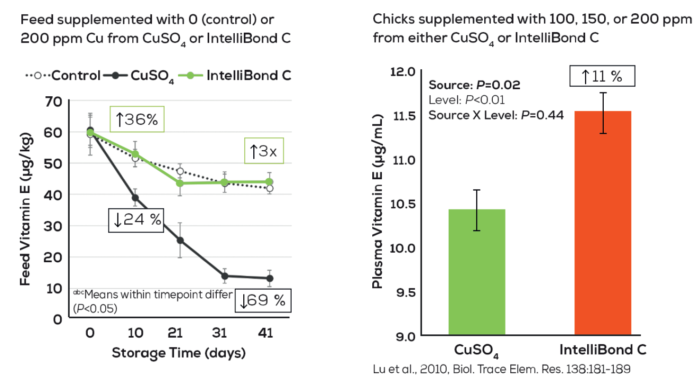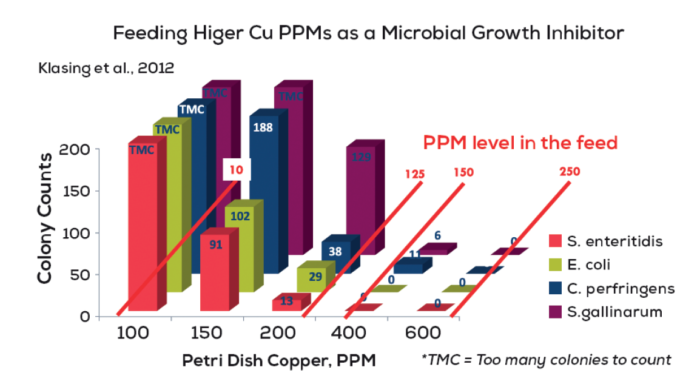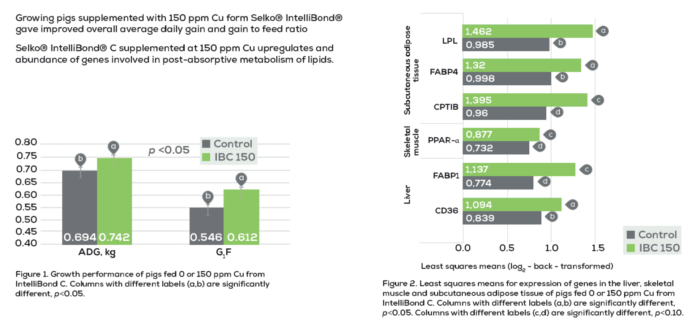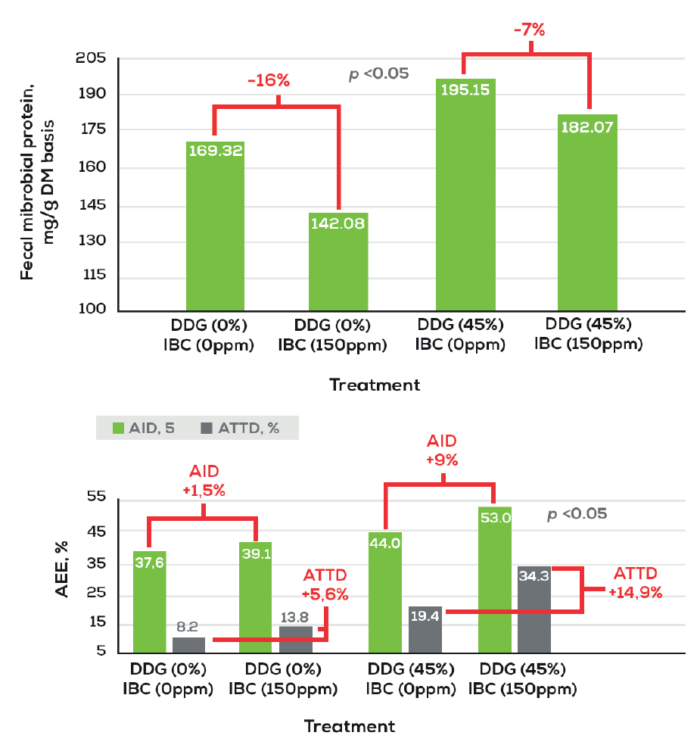Trouw Nutrition researchers found that adding hydroxy chloride copper (IntelliBond®) to swine diets could help improve growth performance and reduce negative interactions between copper and added vitamins or enzymes. The use of high levels of copper also was found to limit the overgrowth of unwanted bacteria helping to manager gut health, increasing average daily gain (ADG) throughout production and improving hot carcass weight.
The primary goal of adding trace minerals to swine diets is to fulfil animals’ nutritional requirements. Feeding the optimal amount of trace mineral allows animals to maintain positive homeostasis supports good performance. Trace minerals are required for important functions, such as optimal fertility and immunity, and are therefore essential nutrients to ensure optimal growth and performance.
A poorly balanced trace mineral supply can have an increasingly negative influence on performance, etc. It is important to remember that the animal will choose how it utilises the nutrients it takes in, and therefore if there is a trace mineral deficiency, the animal’s system will divert the remaining supply to the ‘most vital’ body functions. Therefore, the first visual signs of a deficiency may be ‘less vital’ functions such as growth, reproductive performance and skin integrity.
When supplementing diets with trace minerals, the source matters. Mineral supplementation has evolved since the use of oxide-based trace minerals in the 1930s. Sulphate-based trace minerals were introduced in the 1940s followed by the development
of organic trace minerals in the 1970s. Organic trace minerals improved mineral bioavailability and effectiveness but remained expensive. As it was not always economically viable to replace all sulphate and oxide forms, many producers only partially replaced the use of inorganic mineral sources. Hydroxy trace minerals, developed in the 1990s, provide a concentrated, bioavailable trace mineral source, and offer a way to entirely replace the use of inorganic mineral sources.
Source of copper affects vitamin stability
Copper is a catalyst of several important enzymatic reactions taking part in the antioxidant defence of the body, such as Superoxide Dismutase (SOD). The nutrient supports the functioning of macrophages focused on combating infectious elements, and helps with the formation of collagen and elastin.
However, the source of the copper added to diets can influence both its availability to the animal and the availability of other dietary nutrients. More soluble trace mineral sources (sulphates based trace minerals) can have a negative influence on vitamin stability in feed.
It is well established in the literature that retention of feed vitamins (such as E, A and certain B complex vitamins) over time will vary based on what type of trace minerals were included. For example, feeds containing chelated trace mineral sources retain more vitamin activity over six months, compared to sulphates.
A trial carried out in 2010 examined the stability of vitamin E in feeds supplemented with no trace mineral, or 200ppm of either hydroxy copper or copper sulphate. Researchers found that during a 41-day window, feeds with no supplementation or supplementation with hydroxy-copper maintained similar amounts of vitamin E. Feed with copper sulphate lost about 69% of the vitamin by the end of the trial. Hydroxy copper does not interact with vitamins in feed, meaning more vitamins are left for the animal to use.
Similarly, when chicks received diets supplemented with 100, 150 or 200ppm copper sulphate or hydroxy copper and vitamin E, the amount of vitamin E found in birds’ blood plasma was 11% higher for birds eating feeds with hydroxy copper.
Mineral source And phytase Function
Trace mineral copper source can alter how added enzymes, like phytase, function in diets. In an in vitro study completed in 2006, researchers examined the interaction between supplemental copper and phytase in feeds. The researchers looked at the use of copper citrate, copper chloride, organic copper or copper lysine, copper sulphate and hydroxy copper at levels including 0, 62.5, 125, 250 or 500ppm.
As the amount of copper added to the feed increased, the amount of phosphorous hydrolysis (the amount of phosphorus released from the Phytate molecule) in the diet fell. However, the most extreme negative reactions followed the combination of phytase and copper chloride, copper sulphate and copper citrate. If a high level of one of these types of trace mineral is included in the diet, significantly less Phosphorus could be liberated from the phytate by the activity of the phytase enzyme. This is because Phytate has a high affinity for the soluble trace mineral ions (e.g. Cu2+) which easily dissociate from their ligands (e.g. sulphate) and bind to the phytate, blocking phytase activity. Phytase function remained highest when hydroxy copper was supplemented. Therefore, the use of a trace mineral source which remains insoluble in feed can minimise interference with phytase function.
Figure 1 – Trial results from studies looking at vitamin stability based on trace mineral type.
Extra – Nutritional effects of copper
Copper is required in feed in order to fulfil the animal’s nutritional requirement, which is defined by the amount of Copper available in the small intestine to be absorbed across the intestinal wall. However, by increasing the concentration of copper in the lumen of the gut, copper can help to manage the microbiota in the gut, due to its natural bacteriostatic properties.
Extra-nutritional levels of copper (125 to 250ppm) have been linked to improvements in gut integrity and health, feed efficiency and growth rate. There may be a number of different modes of action involved in these benefits. The use of high levels of copper may function as a bacteriostat in the hindgut – reducing populations of pathogenic bacteria such as clostridium and Salmonella. Research on the topic shows a drop in total anaerobe bacteria and coliform populations following Copper use. It also may play a role in improving the amount of nutrients available for animals by limiting microbial degradation of nutrients.
How much copper is enough? Considering the additive effect in the animal
Where legislative maximum limits on Copper level do not apply, the extra-nutritional benefits can be implemented. But how much Copper is needed in the diet to optimise gut health? Researchers examined what level of Copper is needed to reduce the bacterial populations in contaminated petri dishes. Copper was added to the agar solution at varying concentrations, at 100 ppm, 150ppm, 200ppm, 400ppm and 600ppm. It is worth noting that due to the concentration effect along the GIT, the ‘supplemented in feed’ equivalence is 10ppm, 125ppm, 150ppm and 250ppm respectively, as per Fig.2.
Figure 2 – Relationship among copper levels added to the diet, copper in the lower GIT and control of pathogenic bacteria colonies.
The group found that when 100ppm copper was added, the number of bacteria colonies remained high, which represents 10 ppm in feed, representing the nutritional requirement. It wasn’t until 400ppm copper was added that significant growth inhibition occurred (150ppm in feed equivalence), while adding 600ppm meant that none of the four grew (250ppm in feed).
Implications from high-level copper inclusion
A trial examined the influence of adding 150ppm hydroxy Copper to the diets of growing pigs and tracked the concentration of microbial protein.
A group of pigs received one of two diets, and then switched to the other diet for the second trial period. Diets included two levels of DDGS (0 or 45%) to provide varying protein levels, and two levels of hydroxy C (0 or 150ppm). Faecal matter was collected on days 10, 11 and 12 and ileal digesta was gathered on days 13 and 14.
Figure 3 – Results from high copper inclusion during grow-finish period.
Researchers found that including copper reduced the concentration of faecal microbial protein in the large intestine, indicating that high copper can reduce the total microbial population. However, this effect was less in the diets containing high levels of DDG. In summary, adding 150ppm copper lowered the concentration of microbial protein in the large intestine and improved the apparent ileal digestibility and apparent total tract digestibility of acid hydrolysed ether extract.
The study built off of the understanding that piglet performance and wellbeing were improved when high levels of Copper were added to diets. It sought to expand the understanding of Copper’s mode of action and the role it could play in limiting gram positive and negative bacteria by reducing their draw on essential nutrients. Another trial looked at the potential for supplementing 150ppm hydroxy copper to alter growth performance. The trial examined if the trace minerals could influence gene expression related to lipid metabolism for pigs eating a corn, soybean meal and distillers dried grain (DDGS) diet.
Pigs received a diet with either nutritional levels of hydroxy Copper or 150ppm Copper. Samples were collected from swine liver, skeletal muscle and subcutaneous adipose tissue – to analyse relative mRNA levels of genes related to lipid metabolism.
Pigs receiving 150ppm copper saw overall improvement in average daily gain (ADG) and gain to feed ratio. Swine on the high-Copper diet displayed an upregulated number of genes used in the post-absorptive metabolism of lipids.
Figure 4 – Results from high copper inclusion during grow-finish period.
Copper in grow-finish pig diets.
A trial at Kansas State University, tracked 1,143 swine for 111 days. Diets included a negative control and experimental diets comprised of the negative control feed with 75 or 150ppm copper from a Copper sulphate or hydroxy Copper source.
When 75ppm Copper was added to swine diets, pigs receiving the hydroxy Copper gained more weight than those on the Copper sulphate diet. The difference seemed to peak when pigs reached about 90 kg. Pigs seemed to stop gaining at that point regardless of the type of Copper used in the diet.
When 150ppm Copper was added to diets, pigs on the hydroxy Copper supplement continued to gain weight for longer (to around 110kg) through the production cycle than those fed sulphate trace minerals. This suggests that extra benefits for growth can be seen if high levels of Copper are fed from a hydroxy source compared to sulphate through the entire grow-finish period.
Comparing pigs receiving diets with 150ppm from hydroxy copper and those on a Copper sulphate diet, there was a 2.1kg improvement seen in hydroxy-supplemented pigs.
Meta-analysis of copper trials in swine
Trials conducted at Kansas State University sought to evaluate the influence of adding a high level of hydroxy Copper to the diets of grow-finish pigs compared to swine receiving nutritional levels of the mineral. Pigs were tracked for growth performance and carcass characteristics.
Eight trials from 2013-2018 involved 6,790 swine. Diets included hydroxy Copper at high levels – 75, 150 or 200ppm copper, and the control groups were fed nutritional levels (13-20ppm) of copper from a basal premix.
Findings include:
- Looking at the hot carcass weight of pigs from individual studies based on their diet found that use of high levels of Copper increased weight in almost every trial. Increases ranged from +0.04 to +3.2kg.
- Overall, hot carcass weight for pigs on the high-Copper diets saw a significant improvement as weight grew by 1.31kg compared to results from swine receiving nutritional levels of the trace mineral.
- ADG increased during both the grower and finisher phases and average daily feed intake also improved during the grower phase.
- Pigs receiving higher levels of copper saw bodyweight improvement during the grower and finisher phases.
- Swine on the high-Copper diets saw significant improvement to ADG and average daily feed intake. Swine performance showed benefits in both the grower and finisher phases.
- Improvements in hot carcass weight and growth performance occurred regardless of season.
- Adding high levels of Copper to swine diets increases feeding costs, but the additional weight can provide more benefit depending on the price per kilogram. In an economic analysis, the gain in improvement over feed cost was $0.56 (USD) per pig, showing a strong benefit to farm profitability of supplementing high levels of hydroxy copper source.
Considerations in selecting copper source
Adding high levels of Copper to swine diets can bring weight and carcass improvement through the grow-finish phase and may provide additional economic returns to producers by managing the microbial population on the GIT, as well as impacting nutrient digestibility.
Using a hydroxy Copper, with low solubility in feed means the trace mineral source will not interfere with vitamin stability, or reduce the effectiveness of added enzymes, like phytase. Instead, the mineral will be available to be absorbed in the small intestine, supporting the many important functions within the animal which rely on trace minerals.
About Alice Hibbert
Trouw Nutrition, the animal health division of Nutreco, is a global industry leader in premix and feed additives for animal nutrition, serving some of the worlds ’ largest agri-businesses with nutritional products and services. Selko is Trouw nutrition’s Feed Additive brand.
Prior to working with Trouw Nutrition, Alice worked in the feed compound industry after completing her BSc. (Hons.) in Animal Science at the University of Reading in the UK, with a special focus on poultry nutrition, specifically layer production, and understanding how Folic Acid can affect the deposition of various n-3 polyunsaturated fatty acids in the egg.
In 2015, she moved to Trouw Nutrition, and held many roles in its GB operating company, working as a monogastric nutritionist, supporting the premix business and taking on commercial product management responsibilities. She worked with customers to provide practical nutritional support and helped them apply feed additive programmes at a farm-level, whilst completing her MSc. in applied Poultry Science. She then moved to Selko’s global team, and is currently working as Global Programme Manager Trace Minerals, based in Bangkok. She uses her nutritional knowledge and expertise in trace mineral nutrition to support Asia and Oceania teams, linking technical concepts with market issues to develop programmes for customers.
Written by Alice Hibbert
Source: Feed & Additive Magazine April 2021

